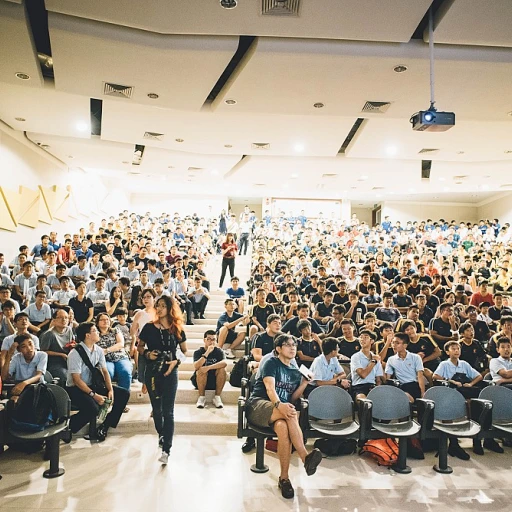
Understanding Applicant Tracking Systems
What is an Applicant Tracking System?
An Applicant Tracking System (ATS) is a software application that automates the recruiting process by managing job applications and tracking candidates throughout the hiring process. It serves as a central hub for recruiting, helping enterprises streamline their talent acquisition efforts. With the increasing demand for top talent, an ATS is essential for managing the influx of applicants and ensuring a smooth application process.
How Does an ATS Support Enterprises?
For enterprise-level organizations, an ATS is not just a tool but a strategic asset. It helps in managing large volumes of job applications, saving time for hiring managers, and improving the overall candidate experience. By automating repetitive tasks, such as sorting resumes and scheduling interviews, an ATS allows HR teams to focus on more strategic initiatives.
Benefits of Using an ATS
- Efficiency: Automates the recruiting process, reducing the time spent on manual tasks.
- Data Management: Centralizes candidate data, making it easier to track and analyze.
- Improved Candidate Experience: Streamlines the application process, making it easier for job seekers to apply for jobs.
- Enhanced Collaboration: Facilitates better communication among hiring managers and recruiters.
Why Enterprises Need an ATS
In today's competitive job market, enterprises need to be agile in their recruiting efforts. An ATS not only helps in managing the sheer volume of applicants but also supports strategic decision-making by providing valuable insights into the hiring process. As enterprises continue to evolve, understanding how to leverage an ATS effectively will be crucial for optimizing applicant tracking and recruiting top talent.
To learn more about how an ATS can enhance your HR processes, you can explore navigating talent tree login for HR success.
Key Features of Enterprise-Level ATS
Essential Components of a Robust ATS
When it comes to enterprise-level applicant tracking systems (ATS), understanding the key features is crucial for optimizing the hiring process. These systems are designed to streamline recruiting by managing the entire lifecycle of talent acquisition, from job posting to onboarding. Here are some essential components that make an ATS effective for large organizations:
- Comprehensive Job Posting: An effective ATS should allow seamless integration with multiple job boards, enabling hiring managers to post jobs efficiently. This feature saves time and ensures that job postings reach a wider audience of potential candidates.
- Advanced Candidate Tracking: Tracking applicants through various stages of the hiring process is vital. A robust system provides real-time updates and insights into candidate progress, helping recruiters make informed decisions quickly.
- Data-Driven Insights: Leveraging data analytics is key to understanding the effectiveness of recruiting strategies. An ATS should offer detailed reports and analytics to help organizations learn from past hiring trends and improve future processes.
- Enhanced Candidate Experience: Providing a smooth application process is essential for attracting top talent. Features like mobile-friendly applications and automated communication can significantly improve the candidate experience.
- Integration with Other HR Systems: For enterprises, it's crucial that the ATS integrates seamlessly with existing HR systems. This integration supports a unified approach to talent management and ensures data consistency across platforms.
Scalability and Customization
Enterprises require an ATS that can scale with their growth and adapt to changing needs. Customizable workflows and flexible configurations allow organizations to tailor the system to their specific recruiting processes. This adaptability is particularly important for enterprises with diverse hiring needs across different departments or regions.
Security and Compliance
With the increasing focus on data privacy, ensuring that an ATS complies with relevant regulations is non-negotiable. Enterprises must choose systems that offer robust security features and adhere to privacy policies to protect candidate information. This not only safeguards data but also builds trust with applicants.
For more insights on navigating HR systems, you can learn more about navigating talent tree login for HR success.
Challenges in Implementing ATS for Enterprises
Overcoming Hurdles in System Integration and Usage
Implementing an Applicant Tracking System (ATS) at the enterprise level presents its fair share of challenges. These systems are pivotal in the recruitment and hiring process, particularly for large organizations that handle a significant influx of applicants and job postings. However, navigating these systems isn't always straightforward. A major challenge is seamlessly integrating the ATS with existing HR and recruiting systems. Enterprises often have multiple platforms in place, and ensuring that these various systems communicate effectively is critical. Fostering a smooth flow of applicant data from job boards to the ATS and beyond can streamline the hiring process. Moreover, enterprises face the challenge of securing and managing vast amounts of sensitive candidate data. Implementing comprehensive privacy policies is essential to protect personal information and maintain compliance with data protection laws. Training hiring managers and HR teams to efficiently utilize the ATS is another crucial aspect. The interface should be intuitive to encourage consistent use by all members involved in the hiring process. Engaging team activities or a detailed case study showcasing successful integrations can be beneficial tools in overcoming these hurdles. Furthermore, the candidate experience must be front and center. Candidates should find the application process easy to navigate when they apply for a job, reinforcing a positive impression of the company. Enterprises need to ensure their tracking systems support a user-friendly application procedure. Success in implementing an ATS requires ongoing collaboration between HR personnel and tech teams, continuously optimizing the system to adapt to the evolving needs of the organization and changes in the job market. As enterprises learn from these challenges and adjust their systems, they can foster a more efficient talent acquisition process and maintain a competitive edge in attracting top talent.Best Practices for Optimizing ATS
Enhancing Efficiency and Candidate Experience
Optimizing an Applicant Tracking System (ATS) for an enterprise is about more than just technological improvements—it's about refining both process and experience. Here are some best practices to truly optimize your ATS:- Streamlining the Hiring Process: Simplifying the application process can significantly enhance the candidate experience. By reducing the time it takes for applicants to apply for jobs, enterprises can ensure they don't lose qualified candidates at the outset. It's crucial to be transparent about the jobs posted and to make sure that job seekers have an easy path to apply job openings.
- Integrating Data Systems: A sophisticated tracking system should seamlessly integrate with other HR data systems. This helps hiring managers to better understand the talent acquisition efforts. Data harmonization ensures that information flows efficiently between systems, assisting in a more accurate and insightful recruiting process.
- Personalizing Candidate Interactions: Enhancing communication strategies within the ATS can support a more personalized candidate experience. From automated messages to regular updates on application statuses, these tools can engage and inform applicants, keeping them interested in the enterprise job opportunities.
- Leveraging AI and Machine Learning: Incorporating artificial intelligence into your ATS can significantly improve the hiring process. AI can help in identifying top talent by reading and analyzing resumes more effectively than manual review, ensuring that the best fit candidates are pushed forward in the recruiting pipeline.
- Adhering to Privacy Policies: With increasing concern over data privacy, ensuring your tracking system aligns with current privacy regulations is imperative. A robust privacy policy that protects applicant data not only safeguards the organization from legal issues but also builds trust with potential hires.
- Improving Hiring Manager Support: An optimized ATS should also cater to the needs of hiring managers by providing them with useful tools and data insights. Training sessions on how to use these systems effectively can be crucial for recruiting efficiency and ensuring a smooth hiring process from start to finish.
Evaluating ATS Vendors for Enterprise Needs
Assessing the Ideal System for Enterprise Use
Selecting the right applicant tracking system (ATS) for an enterprise involves more than just price and basic features. It's essential to consider factors that directly impact the hiring process and talent acquisition strategies. Here are some key aspects to evaluate when choosing an ATS vendor that fits enterprise needs:- Customization and Integration Capabilities: A robust applicant tracking system should seamlessly integrate with existing HR platforms and other business tools. This integration allows data and applications from different sources to work in harmony, aiding in effective recruiting.
- Usability and User Experience: An ATS that's intuitive and easy for hiring managers and recruiters to use can save time and enhance candidate experience. The system should simplify job posting, candidate tracking, and communication tasks.
- Scalability: Enterprises often have high-volume recruiting needs. The chosen system should be able to handle a large number of applications and jobs posted without performance issues.
- Advanced Data Analytics: A good ATS offers tools to analyze recruiting data, helping in understanding hiring trends, bottlenecks, and areas for improvement in the process.
- Support and Reliability: A vendor should provide excellent support services to ensure the system runs smoothly, minimizing downtime and addressing issues quickly when they arise.
- Security and Compliance: Given the strict regulations surrounding data privacy, particularly for job seekers, an enterprise ATS must comply with all relevant legal requirements and have robust security measures in place.
Future Trends in Applicant Tracking for Enterprises
Emerging Trends in Applicant Tracking Systems for Enterprises
The landscape of applicant tracking systems (ATS) is undergoing a dynamic evolution, with technological advancements and changing workforce dynamics paving the way for innovative trends. Enterprises looking to enhance their talent acquisition strategies must stay abreast of these emerging patterns to maintain competitiveness in attracting top talent.
AI and Machine Learning Integration
Artificial intelligence (AI) and machine learning are increasingly being integrated into enterprise ATS solutions. These technologies facilitate smarter recruiting by automating the screening and sourcing processes, thereby reducing the time required to parse through vast pools of candidates. AI helps in predicting candidate success based on data-driven algorithms, streamlining the hiring process and enhancing the candidate experience.
Enhanced Candidate Engagement
Another trend is the prioritization of candidate engagement, with ATS platforms developing features designed to keep applicants informed and engaged throughout the application journey. Automated messaging, status updates, and personalized communication channels are increasingly being incorporated to foster a seamless and transparent application process. This enhanced interaction supports better relationships between hiring managers and potential employees.
Data-Driven Decision Making
Enterprises are becoming increasingly data-centric, using analytics tools within ATS to gain insights into their recruitment efforts. These tools help organizations understand trends from applied jobs, and identify bottlenecks in the recruiting system. With these analytics, enterprises can make informed decisions to optimize their talent acquisition strategies and improve their overall hiring outcomes.
Emphasis on Diversity and Inclusion
Modern ATS platforms are now equipped with features to support diversity and inclusion initiatives. These systems can help identify biases in job descriptions and application processes, ensuring that they promote equal opportunities for all job seekers. This shift not only aligns with global diversity goals but also aids in attracting a broader pool of applicants, enhancing corporate reputation, and fostering a more inclusive workplace environment.
In conclusion, staying informed about the latest trends in ATS is vital for enterprises aiming to optimize their recruitment process. Leveraging these advancements can lead to a more efficient, fair, and engaging process for both employers and applicants.










